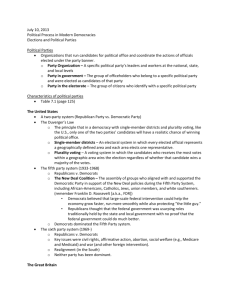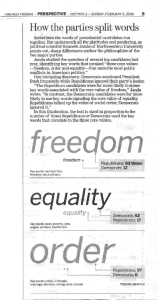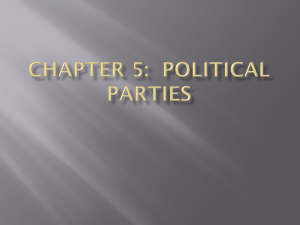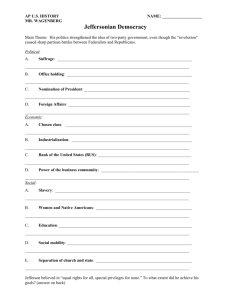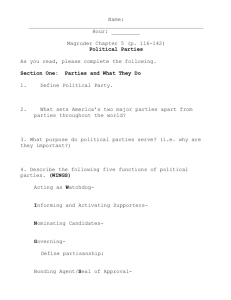Political parties
advertisement
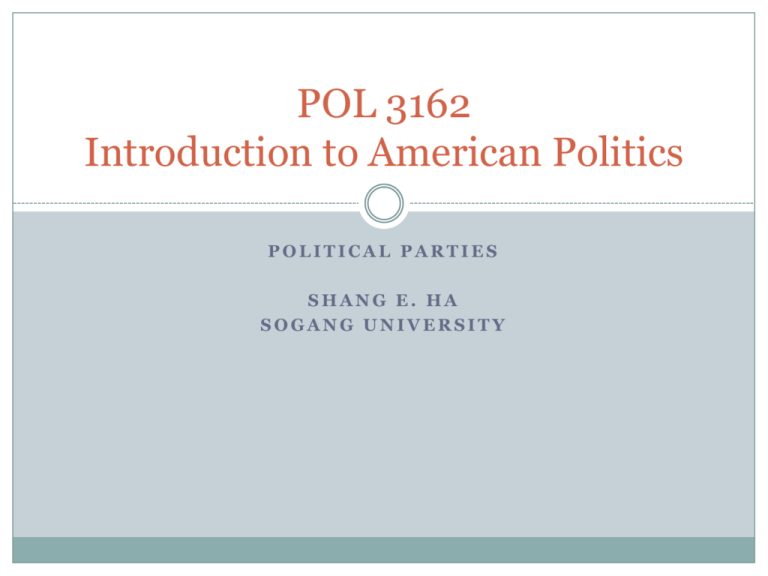
POL 3162 Introduction to American Politics POLITICAL PARTIES SHANG E. HA SOGANG UNIVERSITY Overview APT, Chapter 7 How are parties organized in the United States? (How has the American party system developed over time?) What are the characteristics of modern American political parties? Why parties? What is the role of political parties in American politics? Why do minor parties (if any) exist? What influence do they have on American politics? Two Major Political Parties in the US What Are Political Parties? Political parties – organizations that run candidates for political office and coordinate the actions of officials elected under the party banner. American political parties are best described as a collection of nodes (not unified organizations with party leaders at the top, workers in the middle, and citizen-members at the bottom) Nodes – Groups of people who belong to, are candidates of, or work for a political party, but do not necessarily work together or hold similar policy preferences Three Pieces of American Political Parties Party Organization – A specific political party’s leaders and workers at the national, state, and local levels Party in government – The group of officeholders who belong to a specific political party and were elected as candidates of that party Party in the electorate – The group of citizens who identify with a specific political party History of American Political Parties The First Party System, 1789–1828 Federalists vs. Jeffersonian Republicans The Federalists were the party of Hamilton and Adams and (implicitly) Washington. The Jeffersonian “Democratic-Republicans” were the party of Jefferson and Madison. The Federalists wanted • a strong central government • a national bank • high tariff barriers to protect infant industries • The Jeffersonian “Democratic-Republicans” • free trade (to facilitate their agricultural economy) and • they also feared the concentration of power in the hands of a national government. The Second Party System, 1829–1856 Democrats vs. Whigs 1. The spoils system, the practice of rewarding party supporters with benefits like federal government positions. (Reforming the spoils system would be a major issue in the Progressive Era of the early 20th century.) • Federalists were gone; “Democratic-Republicans” were transformed into the Democratic Party; the Whigs emerged *Political Machine: Unofficial patronage system that tried to acquire political power, government jobs, contracts, and the like for party leaders and supporters 2. Another era. issue was slavery, which could not be resolved in this The Third Party System, 1857–1892 Republicans vs. Democrats The conflict over slavery split the Whigs and ultimately destroyed them, replacing that party with the antislavery Republicans. (that means Democrats were proslavery) Only the Civil War would end slavery, but official racism in the South would continue through Reconstruction and the transformation of the American economy during industrialization. Overall, Republicans dominated the Third Party System. The Fourth Party System, 1893–1932 Republicans and Democrats The rise of William Jennings Bryan in the Democratic Party marked the reshaping of that party, even though he lost the 1896 and 1900 and 1908 elections. (Bryan captured the spirit of the Progressive era.) • Bryan generally favored a large and active federal government. (AND more importantly, support policies to aid farmers and working class city dwellers) • The key issues of the Fourth Party system were the nature of industrialization and the assimilation of America’s swelling immigrant population. • Republicans continued to dominate during this era. The Fifth Party System, 1933–1968 Republicans v. Democrats The New Deal Coalition – The assembly of groups who aligned with and supported the Democratic Party in support of the New Deal policies during the Fifth Party System, including African-Americans, Catholics, Jews, labor union members, and white southerners. (remember Franklin D. Roosevelt [a.k.a., FDR]) • Democrats believed that large-scale federal intervention could help the economy grow faster, run more smoothly while also protecting “the little guy.” • Republicans thought that the federal government was usurping roles traditionally held by the state and local government with no proof that the federal government could do much better. Democrats dominated the Fifth Party system. History of Political Parties: Roosevelt The Sixth Party System, 1969-present Republicans v. Democrats Key issues were civil rights, affirmative action, abortion, social welfare (e.g., Medicare and Medicaid) and war (and other foreign intervention). • • Neither party has been dominant. Both the Republicans and the Democrats became Parties in service. Parties in service – The role of the parties in recruiting, training, contributing to, and campaigning for congressional and presidential candidates. (Candidatecentered politics) Realignment A change in the size or composition of the party coalitions or in the nature of the issues that divide the parties. A good example: White Southerners “Democrat” during the Civil War Now “Republican” Republican and Democratic Brand Names Political Parties: Issue Differences between the Republican and Democratic Parties Ideology of the Parties in Government: 83rd House and 113th House Party Organization • The National Committee is a party’s principal organization, comprised of party representatives from each state. • PACs (political action committees) – Interest groups or divisions of interest groups that can raise money to contribute to campaigns or to spend on ads in support of candidates. • 527 organizations – Named after the section of the tax code that governs them, 527 groups are tax-exempt groups formed primarily to influence elections through voter mobilization efforts and issue ads that do not directly endorse or oppose a candidate. The Limits of Party Organizations Party committees are non-hierarchical; thus the DNC or RNC is ultimately controlled by the committee members, not the chair. Unable to compel state and local parties to do particular things; e.g. state and local parties often adopt platforms that take positions that are relatively “extreme” or out-of-line with the national party. The Party in the Electorate Party Coalitions The groups who identify with a party, often described in demographic terms: NASCAR dads, African Americans, Soccer moms, Evangelical Christians. Activist Someone who spends their own time, effort, and money in supporting a political party or individual Candidate. Party Identification Trends The Impact of Party Identification on Vote Decisions in the 2012 Presidential Election Parties in Politics Parties and Campaigns Parties can help democracy by - putting qualified folks on the ballot - helping them win election - giving citizens clear choices - getting citizens to vote, etc. • Parties are made up of people who are interested in winning first and the goals mentioned above second. • Differences within and between parties and differences between regions make it impossible for all party candidates to work together on all aspects of the party platform in an election. Campaign Platforms A party platform – the list of pledges and promises about what candidates from a party stand for and will fight for if elected; however, candidates are not required to support the party platform, and many ignore key provisions of it (e.g., pro-gun Democrats). Parties in Flux • Unified government – A situation in which one party holds a majority of seats in the House and Senate and the president is a member of the same party. • Party in power – Under unified government, the party that controls the House, Senate, and the presidency. Under divided government, the president’s party. • Divided government – A situation in which the House, Senate, and presidency are not controlled by the same party, such as if Democrats hold the majority of House and Senate seats, and the president is Republican. • Parties are strongest when the are internally homogenous (unified within) and externally heterogeneous (polarized from the other party) Cooperation in Government Developing Agendas Coordination What proposals should the parties offer in Congress? Health care reform, economic stimulus package, environmental protection, etc Negotiation between the parties in Congress regarding certain proposals Accountability (reward and punish government actions based on the performances) The Responsible Party: A system in which each political party’s candidates campaign on the party platform, work together in office to implement the platform, and are judged by voters based on whether they achieve the objectives. (NEVER existed in American Politics) Minor Parties Minor Party: A History In the 1968 Presidential Election, George Wallace (American Independent Party) received about 13% of the popular vote nationwide (more than 9 million votes) Ross Perot (Reform Party) won 8.4% (about 8 million votes) of the popular vote in 1996 and 18.2% (about 19 million votes) in 1992 Ralph Nader (Green Party) won 5% of the popular vote in the 2000 Presidential Election Ralph Nader received almost 100,000 votes in Florida (while Bush won Florida by only a few hundred votes after a disputed recount) The 1968 Presidential Election Duverger’s Law The principle that in a democracy with single-member districts and plurality voting, like the U.S., only one of the two parties’ candidates will have a realistic chance of winning political office. (not applied to the US presidential election due to the electoral college system) Single-member districts – An electoral system in which every elected official represents a geographically defined area and each area elects one representative. Plurality voting – A voting system in which the candidates who receives the most votes within a geographic area wins the election regardless of whether that candidate wins a majority of the votes. Should Parties Choose Their Candidates? (Primary Elections) Types of Primaries and Caucuses
